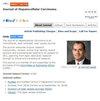Changes in Posttreatment Spleen Volume Associated with Immunotherapy Outcomes for Advanced Hepatocellular Carcinoma
IF 4.2
3区 医学
Q2 ONCOLOGY
引用次数: 0
Abstract
Purpose: We investigated whether spleen volume (SV) changes were associated with treatment outcomes in advanced hepatocellular carcinoma (HCC) patients who received immunotherapy or first-line sorafenib.Patients and Methods: Patients with advanced HCC who underwent immunotherapy or first-line sorafenib at our institute were retrospectively analyzed. CT was used to measure SV before and within 3 months of treatment initiation. Tumor assessment followed Response Evaluation Criteria in Solid Tumors version 1.1. The association between SV change and tumor response or progression-free survival (PFS) was analyzed. The inverse probability of treatment weighting (IPTW) was used to adjust for differences in baseline characteristics.
Results: The immunotherapy group comprised 143 patients (124 men, mean age, 59.8 years ± 11.2 [standard deviation]), while the sorafenib group had 57 (47 men, mean age, 59.6 years ± 9.9). SV increased in 108 (75.5%) immunotherapy and 21 (36.8%) sorafenib patients. In the immunotherapy group, patients with increased SV were more likely than those with decreased SV to have a higher disease control rate (76.9% vs 57.1%, p = 0.024) and durable clinical benefit (52.8% vs 25.7%, p = 0.005). It was also associated with extended PFS in the immunotherapy group in both the univariate (p = 0.028) and multivariate (p = 0.014) analysis. By contrast, in the sorafenib group, an increased in SV was not associated with treatment response but was presumably associated with reduced PFS (p = 0.072) in the multivariate analysis. After IPTW adjustment, the increase in SV remained a significant predictor for DCB and PFS in the immunotherapy group.
Conclusion: Most patients exhibited an increase in SV after the initiation of immunotherapy, which may be used to predict response and prognosis. However, this association was not observed in patients who received sorafenib.
Plain Language Summary: The study provides significant evidence that an increase in spleen volume is associated with better treatment outcomes in advanced hepatocellular carcinoma patients undergoing immunotherapy. These findings offer oncologists a new potential biomarker for optimizing treatment strategies. Specifically, increased spleen volume could be used to predict higher rates of disease control and durable clinical benefits, allowing for more personalized care.
Keywords: hepatocellular carcinoma, immunotherapy, sorafenib, response, survival
晚期肝细胞癌免疫疗法疗效与治疗后脾脏体积的变化有关
目的:我们研究了接受免疫治疗或一线索拉非尼治疗的晚期肝细胞癌(HCC)患者的脾脏体积(SV)变化是否与治疗结果相关:对在我院接受免疫治疗或一线索拉非尼治疗的晚期HCC患者进行回顾性分析。在治疗开始前和治疗开始后3个月内,使用CT测量SV。肿瘤评估遵循实体瘤反应评估标准 1.1 版。分析了 SV 变化与肿瘤反应或无进展生存期 (PFS) 之间的关系。采用逆治疗概率加权法(IPTW)调整基线特征的差异:免疫疗法组有143名患者(124名男性,平均年龄为59.8岁±11.2岁[标准差]),而索拉非尼组有57名患者(47名男性,平均年龄为59.6岁±9.9岁)。108例(75.5%)免疫治疗患者和21例(36.8%)索拉非尼患者的SV有所增加。在免疫治疗组中,SV增加的患者比SV减少的患者更有可能获得更高的疾病控制率(76.9% vs 57.1%,p = 0.024)和持久的临床获益(52.8% vs 25.7%,p = 0.005)。在单变量(p = 0.028)和多变量(p = 0.014)分析中,它还与免疫疗法组的 PFS 延长有关。相比之下,在索拉非尼组,SV的增加与治疗反应无关,但在多变量分析中可能与PFS的减少有关(p = 0.072)。经过IPTW调整后,SV的增加仍然是免疫治疗组DCB和PFS的重要预测因素:结论:大多数患者在开始接受免疫治疗后都会出现 SV 增高,这可用于预测反应和预后。该研究提供了重要证据,表明接受免疫治疗的晚期肝细胞癌患者脾脏体积的增加与更好的治疗效果相关。这些发现为肿瘤学家优化治疗策略提供了一个新的潜在生物标志物。具体来说,脾脏体积的增加可用于预测更高的疾病控制率和持久的临床疗效,从而实现更个性化的治疗。关键词:肝细胞癌、免疫疗法、索拉非尼、反应、生存期
本文章由计算机程序翻译,如有差异,请以英文原文为准。
求助全文
约1分钟内获得全文
求助全文

 求助内容:
求助内容: 应助结果提醒方式:
应助结果提醒方式:


